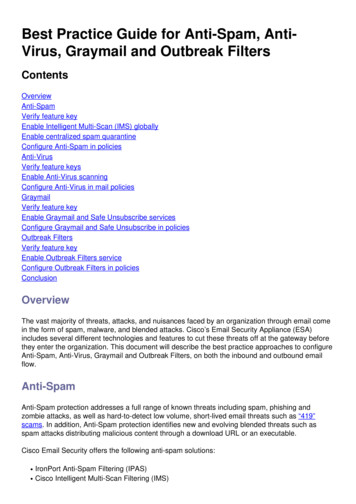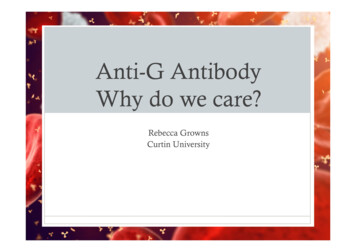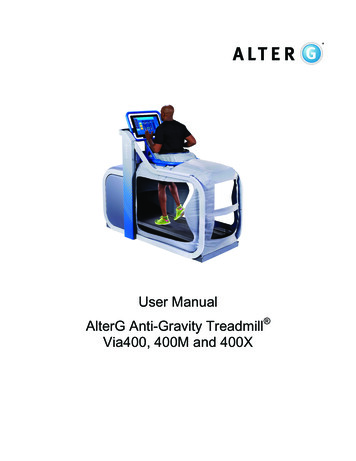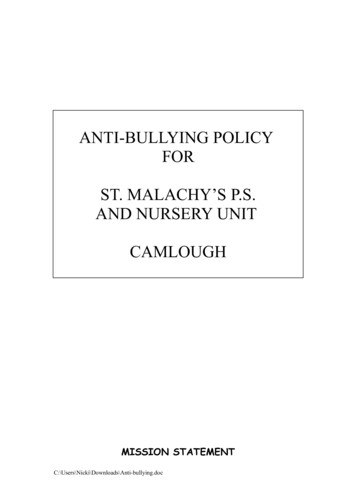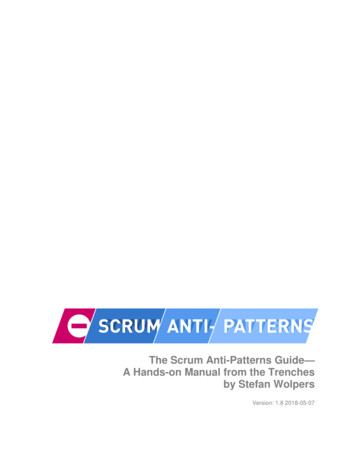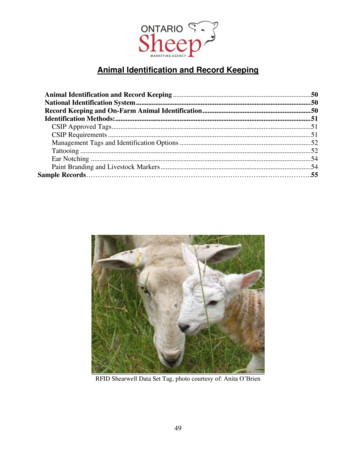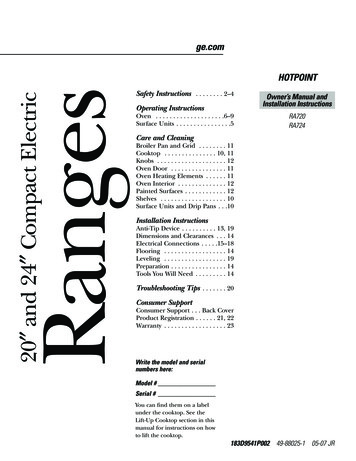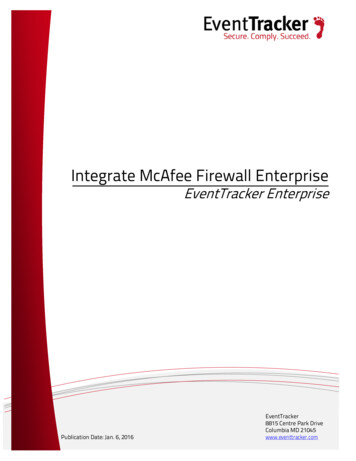
Transcription
Li et al. BMC Pharmacology and Toxicology (2017) 18:5DOI 10.1186/s40360-016-0113-6TECHNICAL ADVANCEOpen AccessIdentification and application of antiinflammatory compounds screening systembased on RAW264.7 cells stably expressingNF-κB-dependent SEAP reporter geneYue Li1,2, Xiaomeng Wang3, Juan Ren4, Xi Lan1,2, Jing Li1,2, Jing Yi1,2, Li Liu1,2, Yan Han1,2, Sanqi Zhang3,Dongmin Li1,2*† and Shemin Lu1,2*†AbstractBackground: NF-κB is one of the key transcription factors in the inflammatory response, transactivates a series ofpro-inflammatory genes and is therefore regarded as an important target for anti-inflammatory drug screening.Method: We recombined the reporter gene vector with inserting the “neo” transcript into the vector pNF-κB-SEAP,made the reporter gene vector stable in a eukaryotic cell line. The recombinant reporter gene vector we namedpNF-κB-SEAP-Neo was transfected into RAW264.7. We selected the transfected RAW264.7 cell line with G418 for15 days and then get RAW264.7 cells stably expressing NF-κB-dependent SEAP named as RAW264.7-pNF-κB-SEAPcells. We treated the RAW264.7-pNF-κB-SEAP cells with NF-κB agonists as LPS, PolyI:C and TNF-α, NF-κB inhibitor asPDTC and BAY117085, in different concentrations and time points and tested the expression of the SEAP,constructed the drug screening system on the base of the RAW264.7-pNF-κB-SEAP cell line. 130 chemicals werescreened with the drug screening system we constructed and one of these chemicals numbered w10 was foundcould inhibit the NF-κB significantly. At last, we verified the inhibition of w10 to expression of genes promoted withNF-κB in HepG2 and Hela, and to migration of Hela.Result: In this study, we established a drug screening system based on RAW264.7 cells that stably expressed theNF-κB-dependent, SEAP reporter gene. To develop a standard method for drug screening using this reporter-genecell line, the test approach of SEAP was optimized and basic conditions for drug screening were chosen. Thisincluded the initial cell number inoculated in a 96-well plate, the optimum agonist, inhibitor of NF-κB pathway andtheir concentrations during screening. Subsequently, 130 newly synthesized compounds were screened using thestable reporter-gene cell line. The anti-inflammatory effects of the candidate compounds obtained were furtherverified in 2 cancer cell lines. The results indicated that compound W10 (methyl 4-(4-(prop-2-yn-1-ylcarbamoyl)phenylcarbamoyl) benzoate) significantly inhibited SEAP production under the screening conditions. Further resultsconfirmed that the precursor compound significantly inhibited the transcription of NF-κB target genes.Conclusion: In conclusion, RAW264.7 cells, stably expressing the NF-κB-dependent SEAP-reporter gene, mayprovide a new, feasible, and efficient cellular drug-screening system.Keywords: Reporter gene, Inflammation, Drug screening, Signal pathway* Correspondence: lidongm@mail.xjtu.edu.cn; lushemin@mail.xjtu.edu.cn†Equal contributors1Department of Biochemistry and Molecular Biology, School of Basic MedicalSciences, Xi’an Jiaotong University Health Science Centre, Xi’an, Shaanxi710061, People’s Republic of ChinaFull list of author information is available at the end of the article The Author(s). 2017 Open Access This article is distributed under the terms of the Creative Commons Attribution 4.0International License (http://creativecommons.org/licenses/by/4.0/), which permits unrestricted use, distribution, andreproduction in any medium, provided you give appropriate credit to the original author(s) and the source, provide a link tothe Creative Commons license, and indicate if changes were made. The Creative Commons Public Domain Dedication o/1.0/) applies to the data made available in this article, unless otherwise stated.
Li et al. BMC Pharmacology and Toxicology (2017) 18:5BackgroundInflammation is a defence response to infection, injury,and/or stress. When acute inflammatory response is triggered, it lasts for a short period and is regulated bynegative feedback signals. Dysregulation of this feedbackmechanism results in chronic inflammation, which is believed to be a key pathophysiological mechanism in various health disorders. In metabolic syndrome, forexample, inflammation seems to be instrumental in thepathogenesis of insulin resistance and hepatic steatosis[1, 2], In various cancers, the inflammatory milieu provides a favourable condition for malignant cells to proliferate and migrate [3].The macrophage, which is ubiquitously-distributed,plays an important role in inflammation. Its functionsinclude phagocytosis, antigen presentation and secretionof different types of cytokines and chemokines to regulate inflammation. In insulin resistance associated withmetabolic syndrome, macrophages secrete proinflammatory cytokines such as tumour necrosis factor (TNF)-αand interleukin (IL)-1β [4] while in primary and metastatic tumours, they provide a proinflammatory microenvironment for cancer cell growth [5]. Based on theirrole in inflammation, macrophage activation has beenrecognized as a target for anti-inflammation therapy.One of the signal transduction pathways involved duringmacrophage activation is the nuclear factor-κB (NF-κB)pathway.NF-κB is a nuclear transcription factor and contains 5subunits: c-Rel, RelA (p65), RelB, NF-κB1 (p50 andp105), and NF-κB2 (p52 and p100) [6]. Inactive NF-κBforms a trimer consisting of RelA, p50, and inhibitorprotein IκB in the cytoplasm. During canonical activation IκB is phosphorylated, separates from the heterodimer RelA/p50 and is degraded via ubiquitination [7]. Atthe same time, the phosphorylated RelA/p50 dimertranslocates into the nucleus, and binds with cis-actingtranscription elements in its target genes [8] to form atranscription complex. NF-κB is known to activate thetranscription of more than 400 genes [9]. During acuteinflammation such as in bacterial infection, activation ofNF-κB up-regulates transcription of various cytokinesand chemokines that promote the inflammatory response and antigen presentation; while during chronicinflammation, NF-κB triggers the transcription of morecomplicated genes that are involved in growth, transformation, and survival of cells [10]. Another differencebetween acute and chronic inflammation is that NF-κBis activated for short and long periods, respectively [11].In both, metabolic syndrome and cancer, NF-κB is activated continuously to promote transcription of severalproinflammatory cytokines [12]. NF-κB also up-regulatesproliferation and migration of tumour cells [6] and playsa major role in the inflammatory microenvironment ofPage 2 of 13the tumour [3]. Besides being a direct trigger and regulator of the inflammatory response, NF-κB is itself regulated through crosstalk with other intracellular signallingpathways [13]. Therefore, macrophages and NF-κB areboth considered as important cellular and molecularscreening targets for anti-inflammation and anti-cancerdrugs [14].In drug screening, the strategy strikingly depends onthe target choice and the assay method [15]. Recently,molecules of the signalling pathway have become newtarget choices for drug screening. Compared with targeting cellular receptors, signal pathway molecules represent the activation or inhibition of a compound withinthe signal pathway more directly, thus requiring identification of the mechanism of action of the screened compound. Regarding assay methods, secreted alkalinephosphatase (SEAP) is extensively used in the detectionof positive candidates [16]. The gene encoding SEAP hasbeen used as a reporter gene in screening and its activityis represented by SEAP-expression yield. SEAP catalysesp-nitrophenyl phosphate (PNPP) into 4-NPP, transforming to yellow and soluble quinones with maximum absorption wavelength at 405 nm [17]. Thus, SEAP activitycan be measured in terms of concentration of quinonesproduced in presence of SEAP. SEAP has several advantages as a reporter gene for drug screening: feasibility ofapplication within the culture supernatant, high stabilityat 65 C, and prolonged half-life [18].In this study, we constructed a drug screening systemtargeting the NF-κB pathway in macrophages. We produced a recombinant pNF-κB-SEAP vector, transfectedmouse macrophages, and obtained a cell line stably expressing the reporter gene. We optimized conditions forthe SEAP test and basic conditions of recombined cellculture and treatment with well-known activators andinhibitors of the NK-κB pathway. A total of 130 newlysynthesized compounds were screened using this drugscreening system and 8 compounds displayed strikinginhibitory activity for SEAP. Compound W10 was selected to evaluate the screening results in HeLa andHepG 2 cells, and the results showed that W10 significantly inhibited the expression of NF-κB targeting genes.MethodsRecombination of vector pNF-κB-SEAPTo recombine the vector pNF-κB-SEAP to be stable ineukaryocyte, we analysed the vector sequence (http://www.addgene.org) and found that there are 2 restrictionsites (SalI and AfeI) downstream of the SEAP transcript.The vector pEGFP-N1 (Clontech) includes the sequenceof neomycin resistance gene “neo”. Therefore, the openreading frame for “neo” was first amplified (forward primer: 5′-GCGTCGACGTCCTGAGGCGGAAAGAA-3′;reverse primer: 5′-CCAGCGCTGGGGTATGTAGGC
Li et al. BMC Pharmacology and Toxicology (2017) 18:5GGTGCTAC-3′) at 71 C annealing temperature, for35 cycles. Subsequently, the 2024-bp target fragmentand the vector pNF-κB-SEAP were digested with the restriction enzymes SalI and AfeI (Fermentas) and thenjoined by T4 DNA ligase (TAKARA) (Fig. 1a). Lastly,the recombinant plasmid, pNF-κB-SEAP-Neo, was sequenced (Beijing Genomics Institute).Establishment of RAW264.7 cells stably expressing NF-κBdependent SEAP reporter geneRAW264.7 cells obtained from the Cell Bank of theChinese Academy of Sciences (Shanghai, China),werecultured in RPMI 1640 medium (Hyclone) with 10%heat-inactivated foetal bovine serum (FBS; Hyclone) at37 C under 5% CO2 and passaged every 2 days. At thethird passage, the cells were inoculated into 6-well plateswith 1 106 per well and cultured overnight until thecells reached 80%–90% confluence. The plasmid pNFκB-SEAP-Neo was extracted with an Endo free PlasmidMini preparation Kit (Omega) and its concentration wasdetermined using a Nanodrop (Thermo Fisher) spectrophotometer. The extracted pNF-κB-SEAP-Neo wastransfected into RAW264.7 cells using Fugene HDTransfection Reagent (Promega). To form the transfection complex, the medium was removed from the wellsand 2 mL fresh RPMI 1640 medium was added. Following this, 2 μg plasmid and 8 μL Transfection ReagentPage 3 of 13diluted in 100 μL RPMI 1640 medium without serumwere mixed for 1 s and added to the wells in a drop-wisemanner, swirled to ensure that the transfection complexcovered the entire plate surface, and incubated for15 min at room temperature.After transfection with pNF-κB-SEAP-Neo plasmid for24 h, RAW264.7 cells were selected with 200 μg/mL G418 (Ameresco). Fresh medium containing 200 μg/mL G418 was replenished every other day, for 15 days.The positive clones of RAW264.7-pNF-κB-SEAP cellswere cultured and proliferated in RPMI 1640 mediumwith 10% FBS and 200 μg/mL G418, at 37 C under 5%CO2, and designated as RAW264.7-pNF-κB-SEAP cells.Alkaline phosphatase activity assayPure CIAP (Takara) was serially diluted in ultrapurewater to obtain a series: 0.8 10-2, 1.6 10-2, 2.4 10-2,3.2 10-2, and 4.0 10-2 U/mL. The substrate reactionbuffer was prepared by dissolving PNPP (Sigma-Aldrich)in 1 mg/mL diethanolamine (DEA) buffer (0.1moL/LDEA, 1moL/L MgCl2, pH 9.8). Subsequently, 50 μL substrate was mixed with 50 μL standard alkaline phosphatase solution and left to react at 37 C for 30 min in thedark. The microplate was then placed in an ice-bath toend the reaction. The absorbance of the product wasread at 405 nm (OD405) and ultrapure-water is used toadjust zero, using a full-wavelength microplate readerFig. 1 Recombined reporter gene vector pNF-κB-SEAP-Neo. a Schematic diagram of the recombined reporter gene vector pNF-κB-SEAP-Neo. The ORFof eukaryotic/ prokaryotic resistance gene NeoR/KanR was amplified from pEGFP-N1 vector and inserted into pNF-κB-SEAP vector between 2 restrictionsites of SalI and AfeI to construct the recombined vector pNF-κB-SEAP-Neo. b Identification of recombined reporter gene vector pNF-κB-SEAP-Neo.Double-restriction-enzyme digestion analysis of SalI and AfeI was performed with 1% agarose gel electrophoresis. Lane 1 is the 1-kb ladder marker.Lane 2 is the restriction enzyme-digested products of the reporter gene vector pNF-κB-SEAP. Lane 3 is the restriction enzyme-digested products ofamplified “Neo” transcript. Lane 4 is the restriction enzyme-digested products of the recombined reporter gene pNF-κB-SEAP-Neo
Li et al. BMC Pharmacology and Toxicology (2017) 18:5(Thermo). Taking OD405 as the abscissa and CIAP activity as the ordinate, a standard curve for SEAP activitywas obtained.When analysing SEAP activity in the culture supernatant, we collected the culture supernatant (150 μL perwell) and heated it at 65 C for 5 min to inactivate otheralkaline phosphatases in the cells and the serum, andmixed 50 μL culture supernatant with 50 μL substratereaction buffer at 37 C and left it to react for 30 min inthe dark. The microplates were then placed in an icebath to end the reaction. Absorbance of the product wasread at 405 nm (OD405) and fresh medium withoutSEAP was used to adjust zero, using a full-wavelengthmicroplate reader (Thermo). The absorbance was considered directly proportional to the activity of SEAP inthe cell supernatant.Optimizing the drug screening system with RAW264.7pNF-κB-SEAPTo determine the optimum number of cells in the initialinoculum for drug screening, the cells were inoculatedin a 96-well plate at concentrations of 10,000, 20,000,40,000, 80,000 and 160,000 cells/well, cultured for 8 h,and incubated in 150 μL/well of high-glucose DMEMwithout phenol red (Hyclone) and with or without lipopolysaccharide (LPS) (100 ng/mL) for 24 h. SEAP activity in the culture supernatant was measured bymicroplate spectrometry.To determine a suitable NF-κB agonist for RAW264.7pNF-κB-SEAP cells, the cells were treated with NF-κBpathway agonists such as LPS, PolyI:C, and TNF-α atdifferent concentrations. SEAP activity in the culturesupernatant was measured at different time points usingmicroplate spectrometry.The optimal quantity of RAW264.7-pNF-κB-SEAP cellinoculum was added to a 96-well plate and cultured inhigh-glucose DMEM without phenol red at 37 C and5% CO2 for 8 h. The cells were then treated for 24 hwith 0.1, 1, 10, or 100 ng/mL LPS (Sigma-Aldrich); 1,10, or 100 μM PolyI:C (Amacia); 1, 10, or 100 ng/mLTNF-α (Peprotech); or in the absence of an agonist asthe control. Following this, the concentrations of SEAPin the samples and control were determined and relativeexpression of SEAP (fold) was calculated using theequation:The relative expression of SEAP ðfoldÞSEAP concentration in the sample¼SEAP concentration inthe controlSimilarly, after inoculation in a 96-well plate and incubated in high-glucose DMEM without phenol red at 37 Cand 5% CO2 for 8 h, the cells were treated with 100 ng/mLLPS, 10nM PolyI:C, or 10 ng/mL TNF-α for 6, 12, or 24 h,Page 4 of 13or without any agonist as the control. SEAP concentrationin the samples and control were determined and the relative activity of SEAP (fold) was calculated using the aboveequation.To determine a NF-κB inhibitor positive control for thedrug screening system, RAW264.7-pNF-κB-SEAP cellswere treated with NF-κB inhibitors pyrrolidinedithiocarbamate (PDTC) [19] or (2E)-3-[[4-(1,1-Dimethylethyl)phenyl] sulfonyl]-2-propenenitrile (BAY117085) [20].After the cells were inoculated in a 96-well plate andcultured with high-glucose DMEM without phenol redat 37 C and 5% CO2 for 2 h, RAW264.7-pNF-κB-SEAPcells with the optimal quantity of inoculum were treatedwith PDTC (Beyotime) and BAY117085 (Beyotime) atthe concentrations of 0.1, 1, 10, and 100 μM for 6 h orwith 1‰ DMSO (v/v) for 6 h as the control. Then, theywere cultured in high-glucose DMEM without phenolred containing 100 ng/mL LPS for 24 h. SEAP concentrations in the samples and control were determined andthe relative expression of SEAP (fold) was calculatedusing the above equation.The screening compoundsUsing our established system, we screened severalseries of compounds, including compounds labelled W(N-(prop-2-ynyl)-4-(substituted phenylcarbonylamino)benzamides) [21], compounds labelled K (2-arylisoquinoline-1, 3(2H, 4H)-diones [22], compounds labelledZ (N-aryl salicylamides) [23], compounds labelled X(diaryl urea) [24], and compounds labelled S (5-(2aminobenzo[d] hiazole-6-yl)-2-methoxy-3-(phenylsulfonylamino) benzamides) [25].Our final screened compound W10 was synthesised asfollows. To the solution of methyl 4-(chlorocarbonyl)benzoate (0.60 g, 3 mmol) in anhydrous THF (10 ml), asolution of 4-amino-N-(prop-2-yn-1-yl) benzamide(0.20 g, 1 mmol) and diisopropylethylamine (1.00 ml,0.006 mol) in anhydrous THF (10 ml) was added dropwise at 0 C. The reaction mixture was then stirred for3.5 h at room temperature. After evaporating the solvent, the residue was dissolved in ethyl acetate (20 ml).The mixture was washed with water, followed by washing with 1 M sodium hydroxide, 1 M diluted hydrogenchloride, and brine; dried over sodium sulphate; and filtered. The filtrate was evaporated under reduced pressure to afford a white solid of 0.21 g. A yield of 67.0%was obtained. W10 is methyl 4-((4-(prop-2-ynylcarbamoyl) phenylcarbamoyl) benzoate with its melting pointbetween 240 C and 242 C. 1H-NMR (400 MHz,DMSO-d6): δ 10.66 (s, 1H), 8.87 (s, 1H), 8.10 (s, 4H),7.89 (s, 4H), 4.06 (s, 2H), 3.90 (s, 3H), 3.13 (s, 1H).HRMS m/z Calculated for C19H17N2O4 [M H] 337.1188, found 337.1178 [21].
Li et al. BMC Pharmacology and Toxicology (2017) 18:5Screening of 130 compounds to find NF-κB inhibitors andverification of the inhibitory effect of the screened compound (W10)After RAW264.7-pNF-κB-SEAP cells at the optimal inoculum concentration were added to 96-well plates andcultured in high-glucose DMEM without phenol red at37 C and 5% CO2 for 2 h, these cells were treated witheach of the 130 compounds at the concentration of10 μM for 6 h or with 1‰ DMSO (v/v) for 6 h as thecontrol. The cells were then cultured in high-glucoseDMEM without phenol red, containing 100 ng/mL LPSfor 24 h. Lastly, SEAP concentration in the samples andcontrol was calculated and the inhibition ratio of compounds to NF-κB was determined using the followingequation:Inhibitory ratio ð%Þ ¼ ð1 relative activity of SEAPÞ 100We tested the inhibitory effect of W10 on the transcription of genes promoted by NF-κB in tumour cell lineswhere NF-κB is known to be continuously activated.HepG 2 and HeLa cell lines obtained from the Cell Bankof the Chinese Academy of Sciences (Shanghai, China)were chosen for this purpose. After inoculation in 6-wellplates at a concentration of 3 105 cells/well and incubation in high-glucose DMEM at 37 C with 5% CO2 for12 h, HepG 2 and HeLa cells were each, treated with 10-5M W10, 10-5M PDTC or 1‰ DMSO (v/v) for 24 h or48 h respectively. We extracted total RNA from thesesamples and tested the transcription of cyclooxygenase(COX)-2, monocyte chemoattractant protein (MCP) 1,and intercellular adhesion molecule (ICAM) 1, which areknown to be promoted by NF-κB.Scratch assayWe inoculated Hela cells at a concentration of 3 105cells/well in 6-well plate and incubated in high-glucoseDMEM at 37 C with 5% CO2 for 12 h, marking off inthe cells with 10 μL tip as straight as possible. The Helacells with mark-off line were treated with 1‰ DMSO (v/v) and 10-5 M W10 in high-glucose DMEM without FBSfor 24 h or 48 h respectively. The scratches in cells wereobserved and photographed with inverted microscope(Nikon Eclipse Ri) at 24 h and 48 h. The 3 fixture positions were selected then photographed and measuredwidth of the scratches at the positions at 24 h and 48 h,statistical the variation of scratches width.Real-time quantitative polymerase chain reactionTotal RNA from the samples was extracted with TriPureIsolation Reagent (Roche) as follows: After removing themedium, 1 mL reagent was added into each well, incubated for 5 min, and then transferred to a fresh 1.5-mLPage 5 of 13Eppendorf tube, where chloroform (0.2 ml per 1 ml ofTriPure) was added. Then, the tubes were vortexed formixing, followed by centrifugation at 12,000 g and 4 Cfor 15 min till the liquid separated into 3 phases. Theaqueous phase was transferred carefully to a new tube,mixed with an equal volume of isopropanol, vibratedgently, and incubated at -20 C overnight to precipitateRNA. The mixture was centrifuged at 12,000 g and 4 Cfor 15 min; then, isopropanol was discarded and 75%ethanol was added. The mixture was subjected to gentlevibration and centrifuged again at 12,000 g and 4 C for15 min. The ethanol was then removed and placed atroom temperature until the RNA was dry and then retrieved with 10 μL diethylpyrocarbonate in water. Thequantity of the RNA was estimated using a Nanodrop(Thermo Fisher) spectrophotometer.Using RNA from the samples as template, cDNA wasprepared and amplified (First Strand cDNA SynthesisKit, Thermo). The amplification system included 5 μgtotal RNA and 1 μL oligo (dT) primer, and the total volume made up to 12 μL with water. This system was incubated at 65 C for 5 min, cooled quickly on ice andthe following reagents were added to a final volume of20 μL: 4 μL 5 Reaction Buffer, 1 μL RiboLock RNaseInhibitor (20U/μL), 2 μL dNTP Mix (10 mM), and 1 μLRevertAid M-MuLV RT (200U/μL). The amplificationmixture was mixed gently, centrifuged instantaneously,and incubated at 42 C for 60 min. The whole amplification reaction was terminated at 70 C for 5 min.In HeLa and HepG 2 cell lines, the transcription of genesencoding MCP1, COX-2, and ICAM1 was detected usingreal-time quantitative polymerase chain reaction (RTqPCR), with iQ5 (Bio-Rad, Hercules, USA) and FastStartUniversal SYBR Green Master (ROX) (Roche) for 40 cycles.The relative gene expression normalized by β-actin was calculated by the 2-ΔΔCT method. Details of the primers usedare shown in Additional file 1: Table S1.StatisticsAll experiments were repeated 3 times, with 3 replicatesper analysis. Significance of difference between samplesand control was determined using the 1 way-ANOVA.All raw values were transformed with EXCEL 2010 andstatistical analysis was performed using Prism 6.0software.ResultsEstablishment of RAW264.7-pNF-κB-SEAP cells stablyexpressing NF-κB-dependent SEAP reporter geneThe reporter gene vector (Clontech) is a transienttransfection plasmid and does not contain the eukaryoticresistant gene for stable transfection. Therefore, it is notsuitable for establishment of the drug screening system(Fig. 1a). There are 2 restriction sites (SalI and AfeI)
Li et al. BMC Pharmacology and Toxicology (2017) 18:5Fig. 2 (See legend on next page.)Page 6 of 13
Li et al. BMC Pharmacology and Toxicology (2017) 18:5Page 7 of 13(See figure on previous page.)Fig. 2 Identification of standard screening method based on RAW264.7 Cell line stably expressing NF-κB-dependent SEAP reporter Gene. a Standard curve of alkaline phosphatase, y 0.0315x, R2 0.9947. b Relationship between OD405 and cell number/well of Raw264.7 cells stably expressing NF-κB dependent SEAP reporter gene (RAW264.7-pNF-κB-SEAP cells)treated with or without LPS. R2 0.9395 (the cells were treated with LPS),and R2 0.9910 (the cells were treated without LPS). c The effect of RAW264.7-pNF-κB-SEAP cells were treated with different concentrations ofLPS for 24 h menifested as column chart of relative activity of SEAP and dose-response stimulation curve with common logarithm of LPS concentration as the ordinate and the stimulation ratio (%) as the abscissa, R2 0.9643. d The RAW264.7-pNF-κB-SEAP cells were treated with PDTC atconcentrations of 0.1, 1, 10, and 100 μM or 1‰ DMSO (v/v) (as control) for 6 h and then treated with LPS in 100 ng/mL for 24 h. The effect ofPDTC on RAW264.7-pNF-κB-SEAP cells was manifested as column chart of relative activity of SEAP and the dose-response inhibition curve between the log10 concentrations of PDTC and the inhibition ratio calculated from SEAP relative activity, R2 0.9802, their relation according to thecommon logarithmic equation. e The RAW264.7-pNF-κB-SEAP cells were treated with BAY117085 at concentrations of 0.1, 1, 10, and 50 μM or1‰ DMSO (v/v) (as control) for 6 h and then treated with LPS in 100 ng/mL for 24 h. The effect of BAY117085 on RAW264.7-pNF-κB-SEAP cellswas manifested as column chart of relative activity of SEAP and the dose-response inhibition curve between the log10 concentrations ofBAY117085 and the inhibition ratio calculated from SEAP relative activity, R2 0.9735, their relation according to the common logarithmic equation. The “*” indicates that the column had significant difference compared with the control, the others marked as “#” and “ ” indicate that thecolumn showed significant difference compared with the column on the leftdownstream of the SEAP transcript in the vector pNFκB-SEAP. We amplified the fragment of neomycin resistance geneNeoR/KanR ORF and TK-PA-terminator inthe vector pEGFP-N1,inserted the fragment into downstream of SEAP transcript of pNF-κB-SEAP (Fig. 1a).The amplified fragment was 2,042 bp long (Fig. 1b).Both pNF-κB-SEAP and the amplified fragment weredigested with SalI and AfeI (Fig. 1b) and then linked toconstruct the recombinant SEAP reporter gene vector(pNF-κB-SEAP-Neo) (Fig. 1a and b). The positive recombinant including pNF-κB-SEAP-Neo was selected onLuria Bertani agar with ampicillin and then proliferatedin order to extract endotoxin-free plasmid for eukaryotictransfection. DNA sequencing showed that there was nomutation in the amplified fragment of the recombinantvector pNF-κB-SEAP-Neo.The extracted pNF-κB-SEAP-Neo was transfected intoRAW264.7 cells. By selection with fresh medium containing 200 μg/mL G418for 15 days,the RAW264.7 cellsstably expressing the SEAP reporter gene (RAW264.7pNF-κB-SEAP cells) were established.Alkaline phosphatase activity assaySEAP reporter gene expression is indicated by its activity; therefore, the concentration of SEAP was determined as its activity per unit volume. Since there is ahigh level of similarity between SEAP and calf intestinealkaline phosphatase (CIAP), the standard curve ofSEAP activity was prepared using CIAP. In the standardcurve, the abscissa denotes different concentrations ofthe standard substance, CIAP; the ordinate denotesOD405, indicating the activity of alkaline phosphataseunder different concentrations of CIAP (Fig. 2a andAdditional file 2). Since CIAP is highly similar to SEAPexcept for the signal peptide, the ordinate denotesOD405, it also reflects the activity of alkaline phosphataseunder different concentrations of SEAP. The equation ofstandard curve is y 0.000315x and R2 0.9947.Therefore, SEAP activity in the culture supernatant canbe calculated using this standard curve or equation usingtheir OD405 values.Construction of a drug screening system based on therecombined cell line, RAW264.7-pNF-κB-SEAPIn order to select the optimal initial inoculum of cellsfor anti-inflammatory drug screen, the activity of SEAPin culture supernatant of the RAW264.7-pNF-κB-SEAPcells with different inocula per cell was determined inthe presence or absence of LPS (100 ng/mL) for 24 h.The results showed that the relationship between thelog2 of initial inoculum and OD405 was consistent withthe agonist dose-response curve, when the initial inoculum ranged from 20,000 to 160,000cells/well (Fig. 2band Additional file 2). Furthermore, when the initial inoculum was 40,000cells/well, the OD405 in the presenceof LPS was significantly higher than that in the absenceof LPS. Therefore, we selected 40,000 cells ofRAW264.7-pNF-κB-SEAP cells/well in a 96-well platefor subsequent experiments. The relationship betweenlog2 of initial inoculum and OD405 was consistent withthe agonist-response curve as well, which further indicated that the RAW264.7-pNF-κB-SEAP cells were successfully established, stable, and can be applied to thescreening of NF-κB-dependent anti-inflammatorycompounds.To activate NF-κB in this cell model, we treated theRAW264.7-pNF-κB-SEAP cells with 3 NF-κB pathway agonists: LPS, TNF-α, and polyI:C for 24 h. The resultsshowed that there was no difference after TNF-α treatment (Additional file 1: Figure S1A and Additional file 2),while SEAP secretion was significantly up-regulated aftertreatment with 10nM polyI:C (Additional file 1: FigureS1B and Additional file 2) and 10 and 100 ng/mL LPS(Fig. 2c and Additional file 2), compared with the control(DMSO group). We found that the relation between excitation ratio of SEAP expression and the concentration of
Li et al. BMC Pharmacology and Toxicology (2017) 18:5Page 8 of 13Table 1 The inhibition ratio of the 130 chemicalsCompound No.Inhibition ratio (%)Compound No.Inhibition ratio (%)Compound No.Inhibition ratio (%)w1-11.65 1.29k26-14.74 2.00z4-44.29 19.53w2-23.07 8.68k27-16.02 1.17z5-39.52 17.50w3-9.38 1.53k281.64 3.12z6-19.94 3.85w4-2.92 2.03k30-14.45 3.33z7-35.50 16.85w5-12.74 2.48k32-13.99 2.33z8-29.85 15.10w6-6.40 2.60k346.06 2.06z9-35.72 16.32w72.21 3.22k35-9.43 2.00z10-13.67 11.87w84.85 5.55k364.81 8.98z11-21.48 7.93w96.41 7.79k37-4.56 0.75z12-22.78 7.29W1027.20 5.91***k38-6.22 1.40z13-38.60 16.45**w1112.99 0.34k33-4.24 3.08z14-42.24 19.10w124.49 8.32k40-4.84 0.62z15-9.32 10.93w13-2.24 2.98x1-10.09 0.37z16-17.9 13.51w14-2.85 2.72x2-13.39 0.83z17-16.95 15.87w1542.95 28.87*x3-6.83 2.87z18-10.58 10.06w1915.76 5.56**x4-9.21
Result: In this study, we established a drug screening system based on RAW264.7 cells that stably expressed the NF-κB-dependent, SEAP reporter gene. To develop a standard method for drug screening using this reporter-gene cell line, the test approach of SEAP was optimized and basic conditions for drug screening were chosen. This
